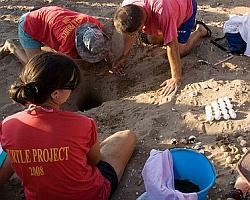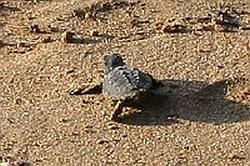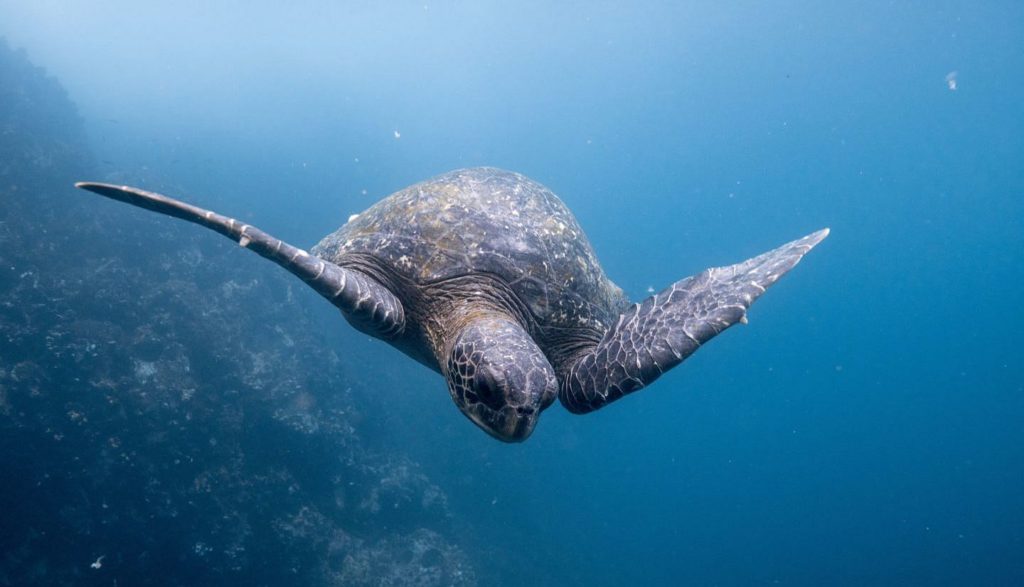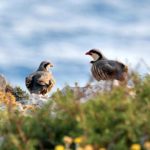The yearly arrival in North Cyprus of the turtle population brings about hectic activity by marine groups, volunteers and the general public! Beaches all over the island are cleared and made ready for female turtles which come to nest all across the shores of North Cyprus.

There are two types of turtles which come to nest in North Cyprus and these are the loggerhead (Caretta Caretta) and green sea (Chelonia Mydas) turtles; they make the yearly journey to nest and then return to the sea, leaving their eggs deep in the sand to hatch. Environmental groups have been active since 1992 in helping to protect these precious and endangered creatures, monitoring the hatchlings to ensure that their survival is as guaranteed as much as possible.
Turtles nest on the same beaches every year, and they also like to nest on the same beaches you like to sunbathe on so please don’t dig your sandcastles too deep or bury the tip of your beach umbrella too far from the seashore as you might accidentally crush or unearth precious eggs! Most nests on the beaches which are monitored now indicate nests with wire cages and coloured rocks though so you should have no worries!
 Nesting and breeding takes place from late May right through to October, when the mature females, usually aged between 20 and 25 years old, will return to the exact beach of their own birth to lay their eggs. They can lay up to an astonishing 100 eggs, but given that the survival rate of baby turtles once in the sea is probably pretty low its not surprising that they lay so many! Once the female has laid her eggs they will then take around 2 months to hatch. Tiny delicate baby turtles have to hatch themselves, struggle to reach the surface through sand and then reach the sea, so you can imagine how much energy they have to use to achieve their goal!
Nesting and breeding takes place from late May right through to October, when the mature females, usually aged between 20 and 25 years old, will return to the exact beach of their own birth to lay their eggs. They can lay up to an astonishing 100 eggs, but given that the survival rate of baby turtles once in the sea is probably pretty low its not surprising that they lay so many! Once the female has laid her eggs they will then take around 2 months to hatch. Tiny delicate baby turtles have to hatch themselves, struggle to reach the surface through sand and then reach the sea, so you can imagine how much energy they have to use to achieve their goal!
This is where the hands and help of groups and volunteers come in handy, with nests being monitored and beaches being cleaned from any debris that could obstruct the babies’ progress. Hatchings are given a helping hand too, with volunteers helping to excavate the nest, taking statistics of each hatchling and then helping them down to the seashore. This then gives the survival rate an extra boost, which is badly needed, but one which will hopefully prolong the life of the species for years to come.

The main groups involved are the Marine Turtle Research Group and SPOT (Society for the Protection of Turtles), and also the local Department of Environment. The research group actively recruit yearly volunteers to help with the nesting season – if you would like to know more about them please visit www.seaturtle.org/mtrg/projects/cyprus or click on the link for SPOT.
If you would like to attend one of the nesting evenings where you can wait to see a female come to lay her eggs on Alagadi Beach during the nesting season, or to experience the sight of an excavation of baby turtles, then you can either contact the Society for the Protection of Turtles on +90 (0)533 846 9563 or you may come across them in the old harbour in Kyrenia and you can book yourself on their list. It’s an experience not to be missed, and one we at Essential Cyprus thoroughly recommend, although patience is required as you might wait a long time for a female to come ashore!

Alternatively you can visit The Hut on Alagadi Beach where volunteers will be happy to help. You can also read a diary which is usually written by one of the volunteers and which appears in the Cyprus Today newspaper, published every Saturday.
One last comment and that is please take note of the following during the nesting season:
- Do NOT go to the beach area between 8pm and 8am during breeding season.
- Do NOT use ANY boat or jet-ski in the 2 mile radius of the protected beach area.
- Do NOT throw plastic bags or bottles and any litter or any food on the beach or in the sea.
- Do NOT dig or use beach umbrellas or sun beds near turtle nests.
- Do NOT bring dogs or any animals onto the beach.
- Do NOT light fires on the beach.
- Do NOT touch baby turtles for your own safety as they may carry salmonella.



